Cultural Intelligence: Analyzing Trompenaar's Model and CQ in Business
VerifiedAdded on 2023/06/07
|5
|1743
|419
Homework Assignment
AI Summary
This assignment explores the concept of cultural intelligence (CQ) through the lens of Trompenaar's "Onion Model," examining its seven dimensions and applying them to the author's own culture. The assignment also addresses the role of demographic data in international management decision-making, defines cultural intelligence from both a theoretical and personal perspective, and reflects on the author's own CQ. Furthermore, it identifies key corporate values of Wesfarmers and considers how to become indispensable at work, emphasizing the importance of cultural intelligence in the modern professional landscape. The assignment draws on academic literature and includes references to support the analysis and insights presented.
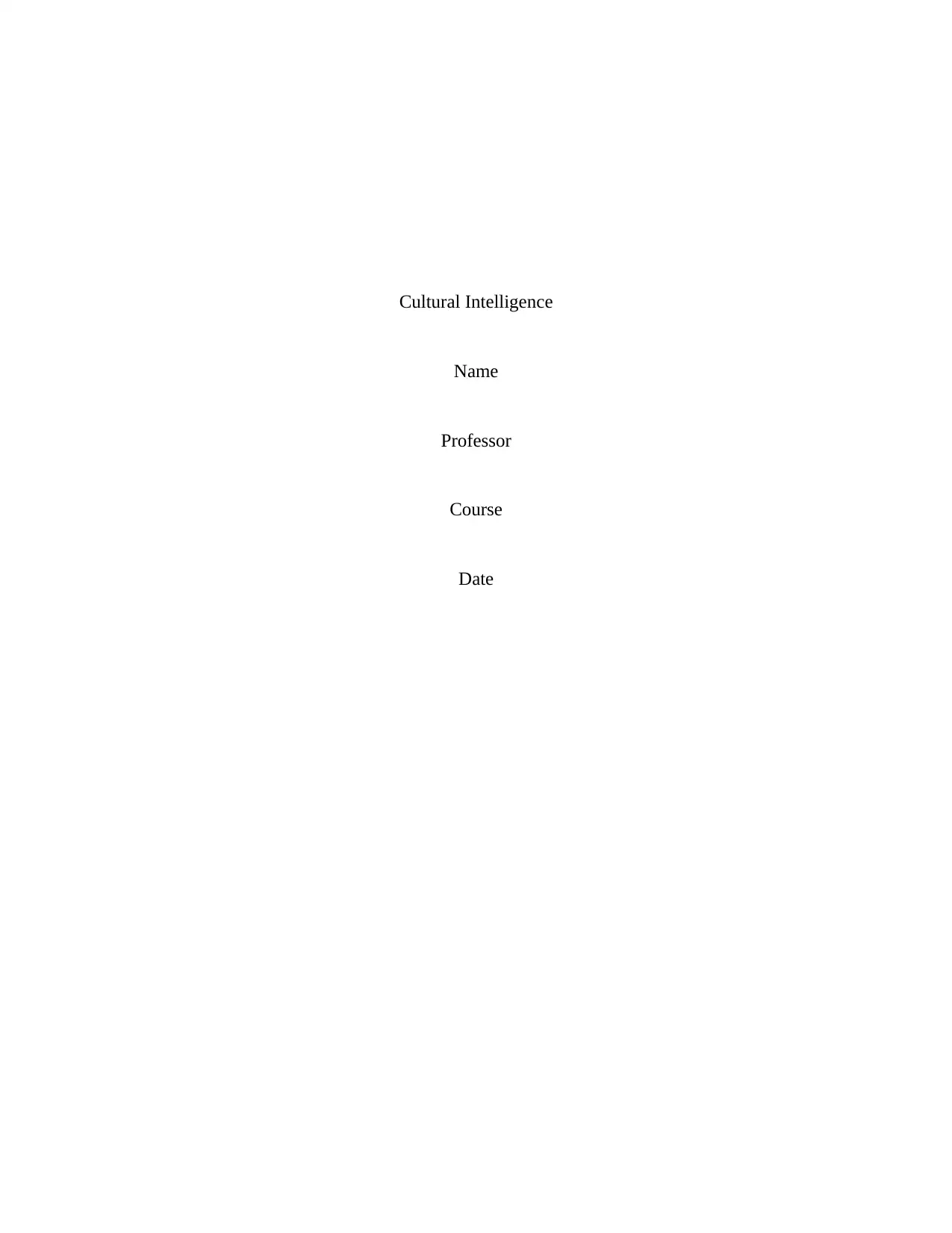
Cultural Intelligence
Name
Professor
Course
Date
Name
Professor
Course
Date
Paraphrase This Document
Need a fresh take? Get an instant paraphrase of this document with our AI Paraphraser
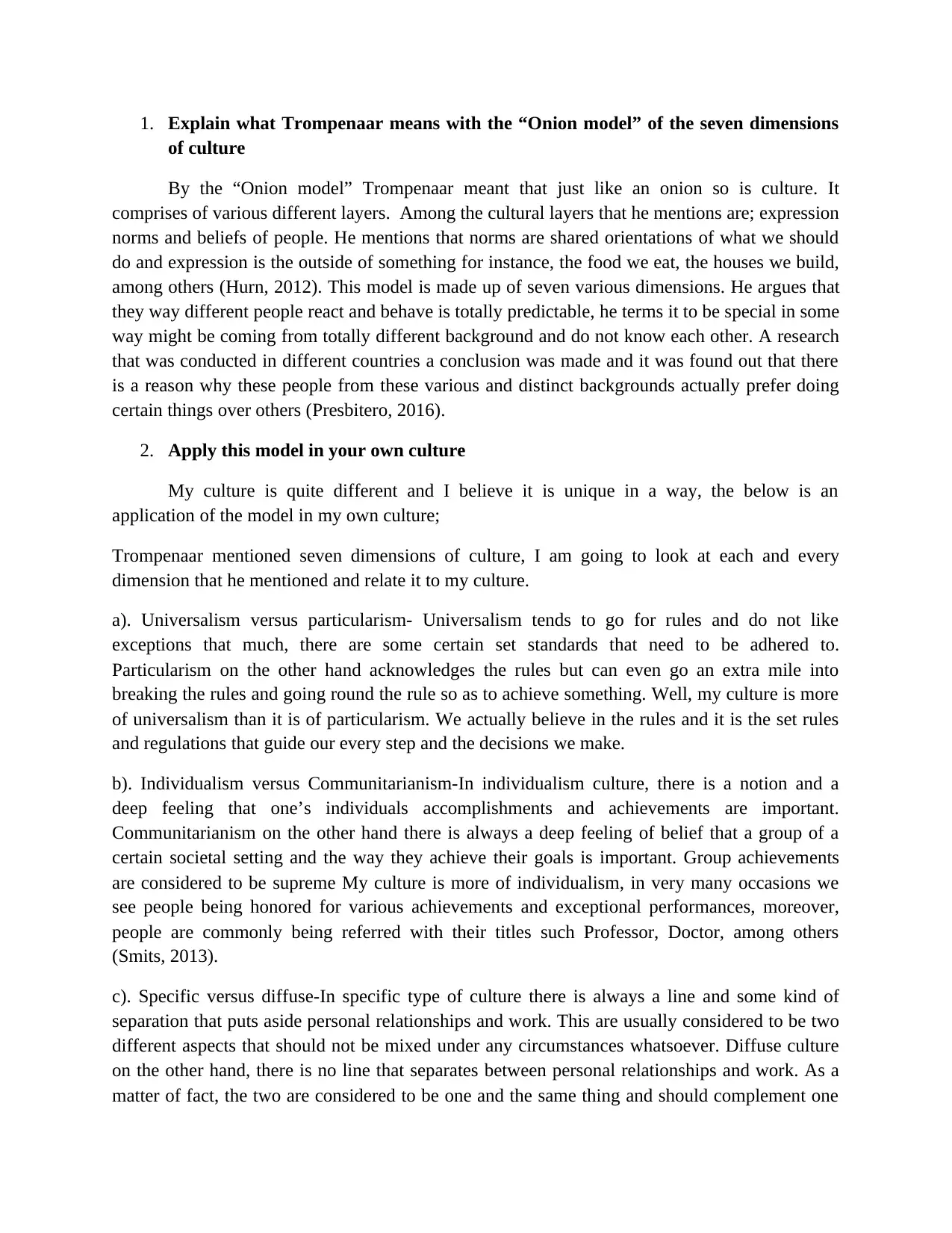
1. Explain what Trompenaar means with the “Onion model” of the seven dimensions
of culture
By the “Onion model” Trompenaar meant that just like an onion so is culture. It
comprises of various different layers. Among the cultural layers that he mentions are; expression
norms and beliefs of people. He mentions that norms are shared orientations of what we should
do and expression is the outside of something for instance, the food we eat, the houses we build,
among others (Hurn, 2012). This model is made up of seven various dimensions. He argues that
they way different people react and behave is totally predictable, he terms it to be special in some
way might be coming from totally different background and do not know each other. A research
that was conducted in different countries a conclusion was made and it was found out that there
is a reason why these people from these various and distinct backgrounds actually prefer doing
certain things over others (Presbitero, 2016).
2. Apply this model in your own culture
My culture is quite different and I believe it is unique in a way, the below is an
application of the model in my own culture;
Trompenaar mentioned seven dimensions of culture, I am going to look at each and every
dimension that he mentioned and relate it to my culture.
a). Universalism versus particularism- Universalism tends to go for rules and do not like
exceptions that much, there are some certain set standards that need to be adhered to.
Particularism on the other hand acknowledges the rules but can even go an extra mile into
breaking the rules and going round the rule so as to achieve something. Well, my culture is more
of universalism than it is of particularism. We actually believe in the rules and it is the set rules
and regulations that guide our every step and the decisions we make.
b). Individualism versus Communitarianism-In individualism culture, there is a notion and a
deep feeling that one’s individuals accomplishments and achievements are important.
Communitarianism on the other hand there is always a deep feeling of belief that a group of a
certain societal setting and the way they achieve their goals is important. Group achievements
are considered to be supreme My culture is more of individualism, in very many occasions we
see people being honored for various achievements and exceptional performances, moreover,
people are commonly being referred with their titles such Professor, Doctor, among others
(Smits, 2013).
c). Specific versus diffuse-In specific type of culture there is always a line and some kind of
separation that puts aside personal relationships and work. This are usually considered to be two
different aspects that should not be mixed under any circumstances whatsoever. Diffuse culture
on the other hand, there is no line that separates between personal relationships and work. As a
matter of fact, the two are considered to be one and the same thing and should complement one
of culture
By the “Onion model” Trompenaar meant that just like an onion so is culture. It
comprises of various different layers. Among the cultural layers that he mentions are; expression
norms and beliefs of people. He mentions that norms are shared orientations of what we should
do and expression is the outside of something for instance, the food we eat, the houses we build,
among others (Hurn, 2012). This model is made up of seven various dimensions. He argues that
they way different people react and behave is totally predictable, he terms it to be special in some
way might be coming from totally different background and do not know each other. A research
that was conducted in different countries a conclusion was made and it was found out that there
is a reason why these people from these various and distinct backgrounds actually prefer doing
certain things over others (Presbitero, 2016).
2. Apply this model in your own culture
My culture is quite different and I believe it is unique in a way, the below is an
application of the model in my own culture;
Trompenaar mentioned seven dimensions of culture, I am going to look at each and every
dimension that he mentioned and relate it to my culture.
a). Universalism versus particularism- Universalism tends to go for rules and do not like
exceptions that much, there are some certain set standards that need to be adhered to.
Particularism on the other hand acknowledges the rules but can even go an extra mile into
breaking the rules and going round the rule so as to achieve something. Well, my culture is more
of universalism than it is of particularism. We actually believe in the rules and it is the set rules
and regulations that guide our every step and the decisions we make.
b). Individualism versus Communitarianism-In individualism culture, there is a notion and a
deep feeling that one’s individuals accomplishments and achievements are important.
Communitarianism on the other hand there is always a deep feeling of belief that a group of a
certain societal setting and the way they achieve their goals is important. Group achievements
are considered to be supreme My culture is more of individualism, in very many occasions we
see people being honored for various achievements and exceptional performances, moreover,
people are commonly being referred with their titles such Professor, Doctor, among others
(Smits, 2013).
c). Specific versus diffuse-In specific type of culture there is always a line and some kind of
separation that puts aside personal relationships and work. This are usually considered to be two
different aspects that should not be mixed under any circumstances whatsoever. Diffuse culture
on the other hand, there is no line that separates between personal relationships and work. As a
matter of fact, the two are considered to be one and the same thing and should complement one
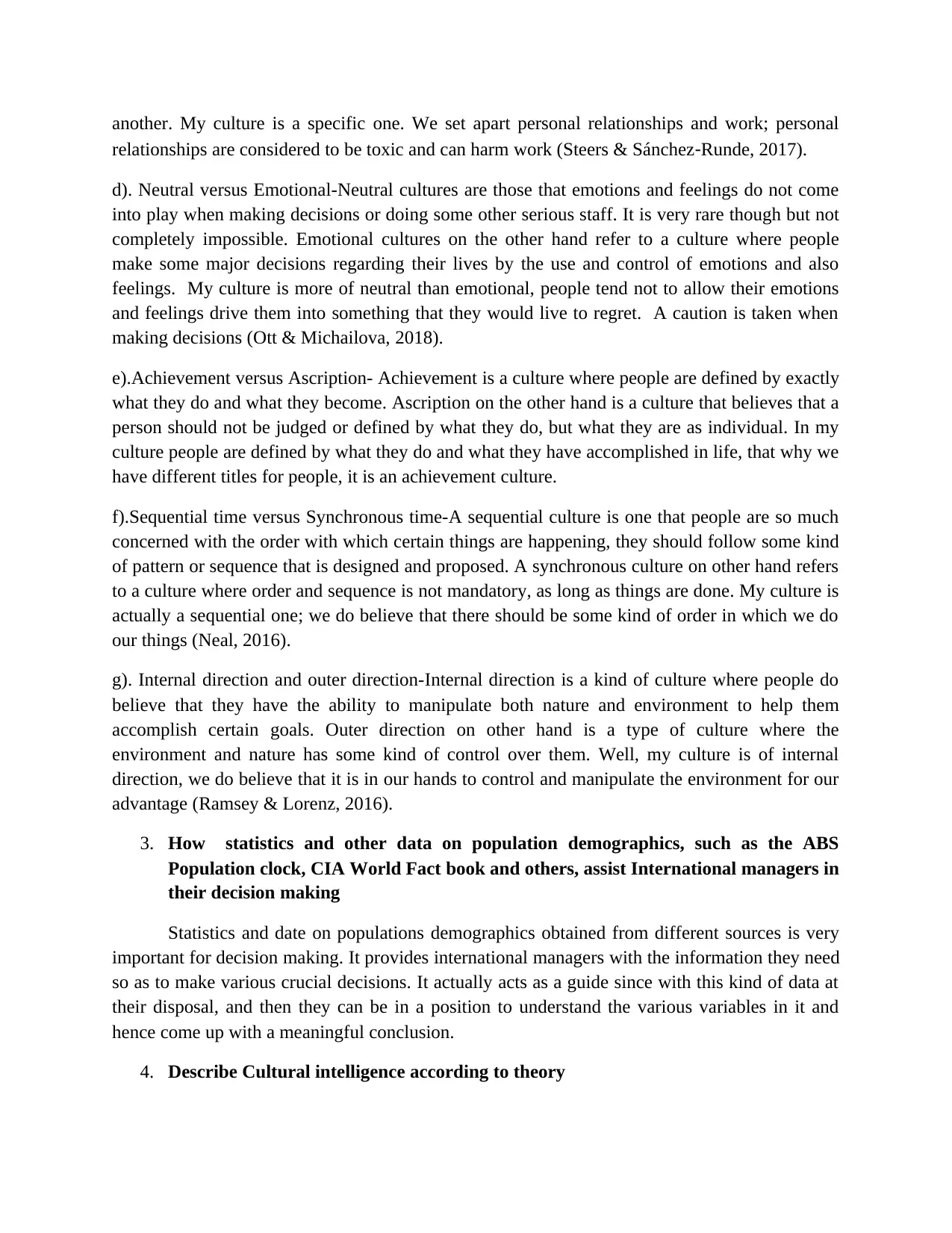
another. My culture is a specific one. We set apart personal relationships and work; personal
relationships are considered to be toxic and can harm work (Steers & Sánchez‐Runde, 2017).
d). Neutral versus Emotional-Neutral cultures are those that emotions and feelings do not come
into play when making decisions or doing some other serious staff. It is very rare though but not
completely impossible. Emotional cultures on the other hand refer to a culture where people
make some major decisions regarding their lives by the use and control of emotions and also
feelings. My culture is more of neutral than emotional, people tend not to allow their emotions
and feelings drive them into something that they would live to regret. A caution is taken when
making decisions (Ott & Michailova, 2018).
e).Achievement versus Ascription- Achievement is a culture where people are defined by exactly
what they do and what they become. Ascription on the other hand is a culture that believes that a
person should not be judged or defined by what they do, but what they are as individual. In my
culture people are defined by what they do and what they have accomplished in life, that why we
have different titles for people, it is an achievement culture.
f).Sequential time versus Synchronous time-A sequential culture is one that people are so much
concerned with the order with which certain things are happening, they should follow some kind
of pattern or sequence that is designed and proposed. A synchronous culture on other hand refers
to a culture where order and sequence is not mandatory, as long as things are done. My culture is
actually a sequential one; we do believe that there should be some kind of order in which we do
our things (Neal, 2016).
g). Internal direction and outer direction-Internal direction is a kind of culture where people do
believe that they have the ability to manipulate both nature and environment to help them
accomplish certain goals. Outer direction on other hand is a type of culture where the
environment and nature has some kind of control over them. Well, my culture is of internal
direction, we do believe that it is in our hands to control and manipulate the environment for our
advantage (Ramsey & Lorenz, 2016).
3. How statistics and other data on population demographics, such as the ABS
Population clock, CIA World Fact book and others, assist International managers in
their decision making
Statistics and date on populations demographics obtained from different sources is very
important for decision making. It provides international managers with the information they need
so as to make various crucial decisions. It actually acts as a guide since with this kind of data at
their disposal, and then they can be in a position to understand the various variables in it and
hence come up with a meaningful conclusion.
4. Describe Cultural intelligence according to theory
relationships are considered to be toxic and can harm work (Steers & Sánchez‐Runde, 2017).
d). Neutral versus Emotional-Neutral cultures are those that emotions and feelings do not come
into play when making decisions or doing some other serious staff. It is very rare though but not
completely impossible. Emotional cultures on the other hand refer to a culture where people
make some major decisions regarding their lives by the use and control of emotions and also
feelings. My culture is more of neutral than emotional, people tend not to allow their emotions
and feelings drive them into something that they would live to regret. A caution is taken when
making decisions (Ott & Michailova, 2018).
e).Achievement versus Ascription- Achievement is a culture where people are defined by exactly
what they do and what they become. Ascription on the other hand is a culture that believes that a
person should not be judged or defined by what they do, but what they are as individual. In my
culture people are defined by what they do and what they have accomplished in life, that why we
have different titles for people, it is an achievement culture.
f).Sequential time versus Synchronous time-A sequential culture is one that people are so much
concerned with the order with which certain things are happening, they should follow some kind
of pattern or sequence that is designed and proposed. A synchronous culture on other hand refers
to a culture where order and sequence is not mandatory, as long as things are done. My culture is
actually a sequential one; we do believe that there should be some kind of order in which we do
our things (Neal, 2016).
g). Internal direction and outer direction-Internal direction is a kind of culture where people do
believe that they have the ability to manipulate both nature and environment to help them
accomplish certain goals. Outer direction on other hand is a type of culture where the
environment and nature has some kind of control over them. Well, my culture is of internal
direction, we do believe that it is in our hands to control and manipulate the environment for our
advantage (Ramsey & Lorenz, 2016).
3. How statistics and other data on population demographics, such as the ABS
Population clock, CIA World Fact book and others, assist International managers in
their decision making
Statistics and date on populations demographics obtained from different sources is very
important for decision making. It provides international managers with the information they need
so as to make various crucial decisions. It actually acts as a guide since with this kind of data at
their disposal, and then they can be in a position to understand the various variables in it and
hence come up with a meaningful conclusion.
4. Describe Cultural intelligence according to theory
⊘ This is a preview!⊘
Do you want full access?
Subscribe today to unlock all pages.

Trusted by 1+ million students worldwide
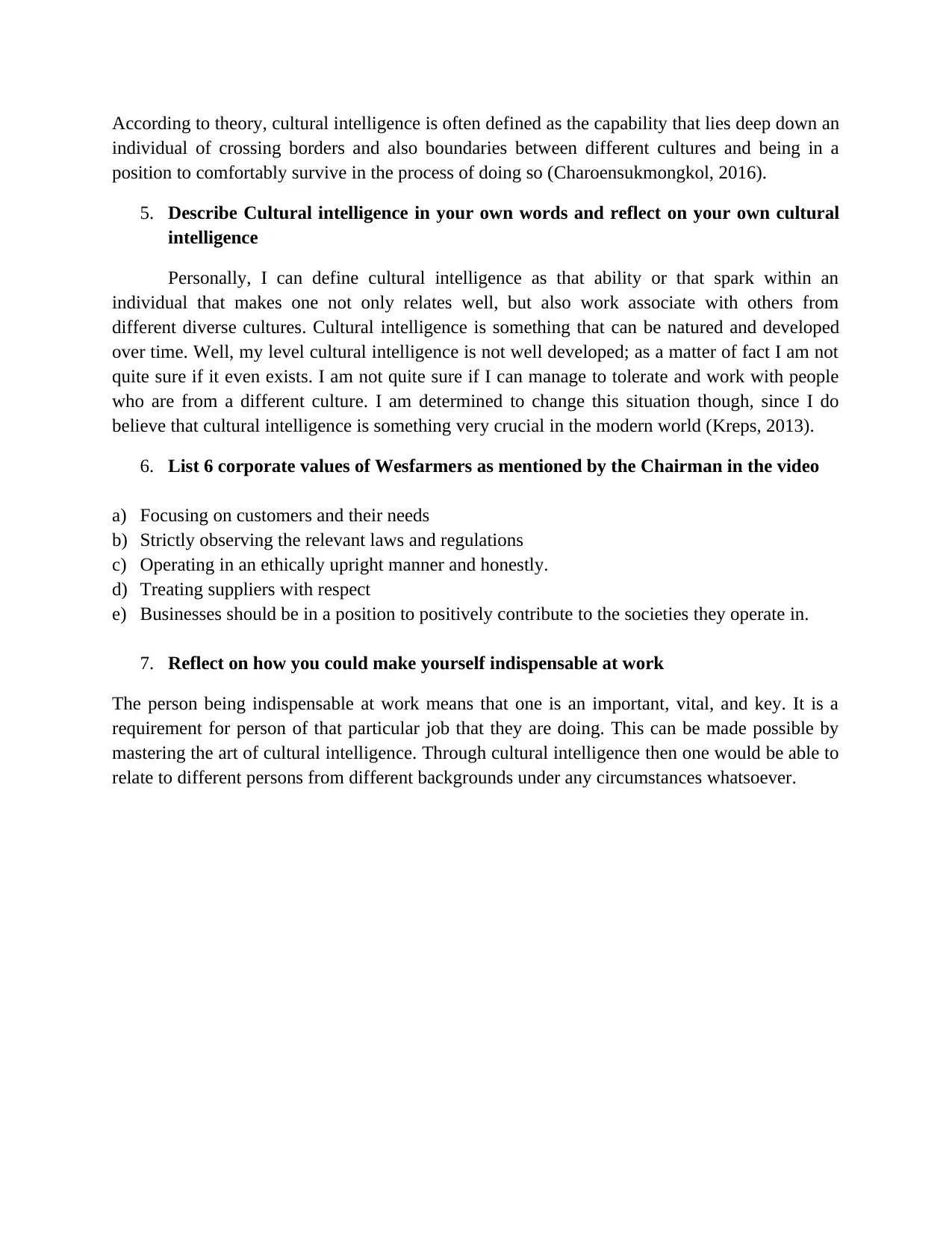
According to theory, cultural intelligence is often defined as the capability that lies deep down an
individual of crossing borders and also boundaries between different cultures and being in a
position to comfortably survive in the process of doing so (Charoensukmongkol, 2016).
5. Describe Cultural intelligence in your own words and reflect on your own cultural
intelligence
Personally, I can define cultural intelligence as that ability or that spark within an
individual that makes one not only relates well, but also work associate with others from
different diverse cultures. Cultural intelligence is something that can be natured and developed
over time. Well, my level cultural intelligence is not well developed; as a matter of fact I am not
quite sure if it even exists. I am not quite sure if I can manage to tolerate and work with people
who are from a different culture. I am determined to change this situation though, since I do
believe that cultural intelligence is something very crucial in the modern world (Kreps, 2013).
6. List 6 corporate values of Wesfarmers as mentioned by the Chairman in the video
a) Focusing on customers and their needs
b) Strictly observing the relevant laws and regulations
c) Operating in an ethically upright manner and honestly.
d) Treating suppliers with respect
e) Businesses should be in a position to positively contribute to the societies they operate in.
7. Reflect on how you could make yourself indispensable at work
The person being indispensable at work means that one is an important, vital, and key. It is a
requirement for person of that particular job that they are doing. This can be made possible by
mastering the art of cultural intelligence. Through cultural intelligence then one would be able to
relate to different persons from different backgrounds under any circumstances whatsoever.
individual of crossing borders and also boundaries between different cultures and being in a
position to comfortably survive in the process of doing so (Charoensukmongkol, 2016).
5. Describe Cultural intelligence in your own words and reflect on your own cultural
intelligence
Personally, I can define cultural intelligence as that ability or that spark within an
individual that makes one not only relates well, but also work associate with others from
different diverse cultures. Cultural intelligence is something that can be natured and developed
over time. Well, my level cultural intelligence is not well developed; as a matter of fact I am not
quite sure if it even exists. I am not quite sure if I can manage to tolerate and work with people
who are from a different culture. I am determined to change this situation though, since I do
believe that cultural intelligence is something very crucial in the modern world (Kreps, 2013).
6. List 6 corporate values of Wesfarmers as mentioned by the Chairman in the video
a) Focusing on customers and their needs
b) Strictly observing the relevant laws and regulations
c) Operating in an ethically upright manner and honestly.
d) Treating suppliers with respect
e) Businesses should be in a position to positively contribute to the societies they operate in.
7. Reflect on how you could make yourself indispensable at work
The person being indispensable at work means that one is an important, vital, and key. It is a
requirement for person of that particular job that they are doing. This can be made possible by
mastering the art of cultural intelligence. Through cultural intelligence then one would be able to
relate to different persons from different backgrounds under any circumstances whatsoever.
Paraphrase This Document
Need a fresh take? Get an instant paraphrase of this document with our AI Paraphraser
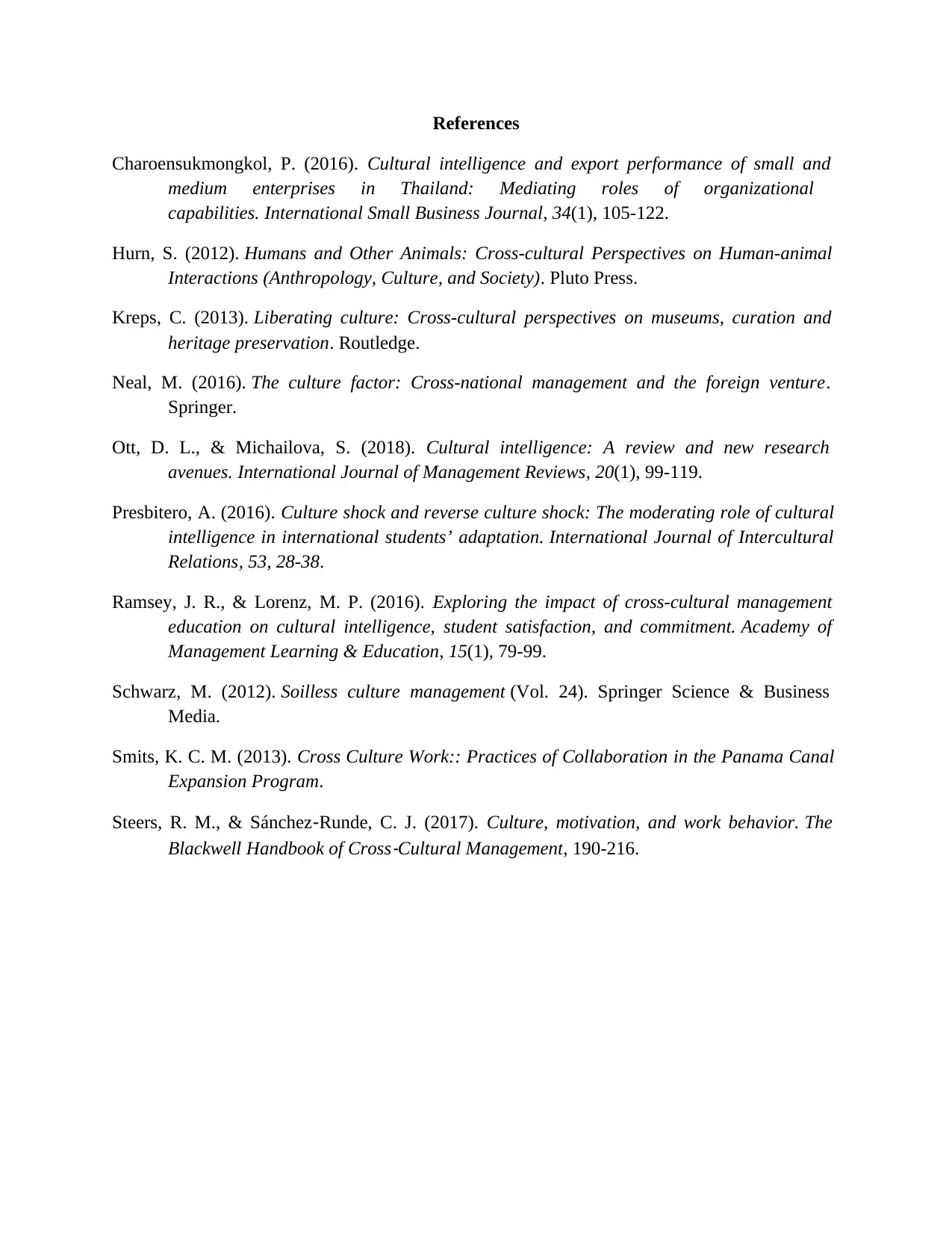
References
Charoensukmongkol, P. (2016). Cultural intelligence and export performance of small and
medium enterprises in Thailand: Mediating roles of organizational
capabilities. International Small Business Journal, 34(1), 105-122.
Hurn, S. (2012). Humans and Other Animals: Cross-cultural Perspectives on Human-animal
Interactions (Anthropology, Culture, and Society). Pluto Press.
Kreps, C. (2013). Liberating culture: Cross-cultural perspectives on museums, curation and
heritage preservation. Routledge.
Neal, M. (2016). The culture factor: Cross-national management and the foreign venture.
Springer.
Ott, D. L., & Michailova, S. (2018). Cultural intelligence: A review and new research
avenues. International Journal of Management Reviews, 20(1), 99-119.
Presbitero, A. (2016). Culture shock and reverse culture shock: The moderating role of cultural
intelligence in international students’ adaptation. International Journal of Intercultural
Relations, 53, 28-38.
Ramsey, J. R., & Lorenz, M. P. (2016). Exploring the impact of cross-cultural management
education on cultural intelligence, student satisfaction, and commitment. Academy of
Management Learning & Education, 15(1), 79-99.
Schwarz, M. (2012). Soilless culture management (Vol. 24). Springer Science & Business
Media.
Smits, K. C. M. (2013). Cross Culture Work:: Practices of Collaboration in the Panama Canal
Expansion Program.
Steers, R. M., & Sánchez‐Runde, C. J. (2017). Culture, motivation, and work behavior. The
Blackwell Handbook of Cross
‐Cultural Management, 190-216.
Charoensukmongkol, P. (2016). Cultural intelligence and export performance of small and
medium enterprises in Thailand: Mediating roles of organizational
capabilities. International Small Business Journal, 34(1), 105-122.
Hurn, S. (2012). Humans and Other Animals: Cross-cultural Perspectives on Human-animal
Interactions (Anthropology, Culture, and Society). Pluto Press.
Kreps, C. (2013). Liberating culture: Cross-cultural perspectives on museums, curation and
heritage preservation. Routledge.
Neal, M. (2016). The culture factor: Cross-national management and the foreign venture.
Springer.
Ott, D. L., & Michailova, S. (2018). Cultural intelligence: A review and new research
avenues. International Journal of Management Reviews, 20(1), 99-119.
Presbitero, A. (2016). Culture shock and reverse culture shock: The moderating role of cultural
intelligence in international students’ adaptation. International Journal of Intercultural
Relations, 53, 28-38.
Ramsey, J. R., & Lorenz, M. P. (2016). Exploring the impact of cross-cultural management
education on cultural intelligence, student satisfaction, and commitment. Academy of
Management Learning & Education, 15(1), 79-99.
Schwarz, M. (2012). Soilless culture management (Vol. 24). Springer Science & Business
Media.
Smits, K. C. M. (2013). Cross Culture Work:: Practices of Collaboration in the Panama Canal
Expansion Program.
Steers, R. M., & Sánchez‐Runde, C. J. (2017). Culture, motivation, and work behavior. The
Blackwell Handbook of Cross
‐Cultural Management, 190-216.
1 out of 5
Related Documents
Your All-in-One AI-Powered Toolkit for Academic Success.
+13062052269
info@desklib.com
Available 24*7 on WhatsApp / Email
![[object Object]](/_next/static/media/star-bottom.7253800d.svg)
Unlock your academic potential
Copyright © 2020–2025 A2Z Services. All Rights Reserved. Developed and managed by ZUCOL.



